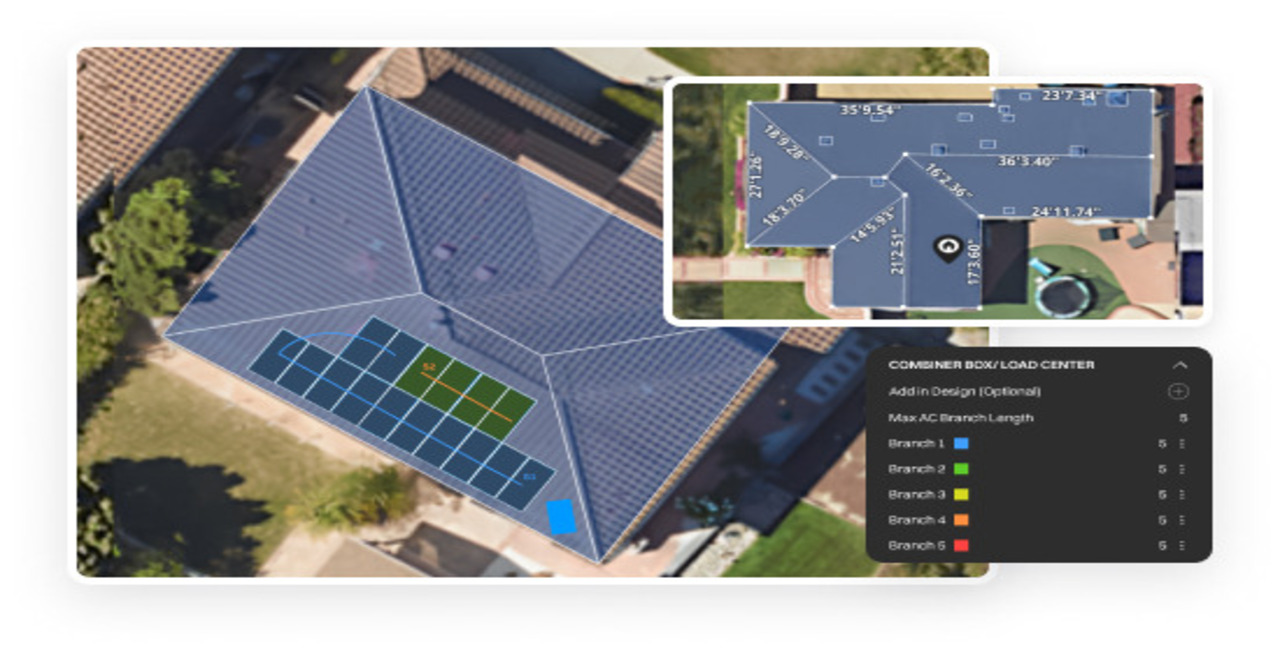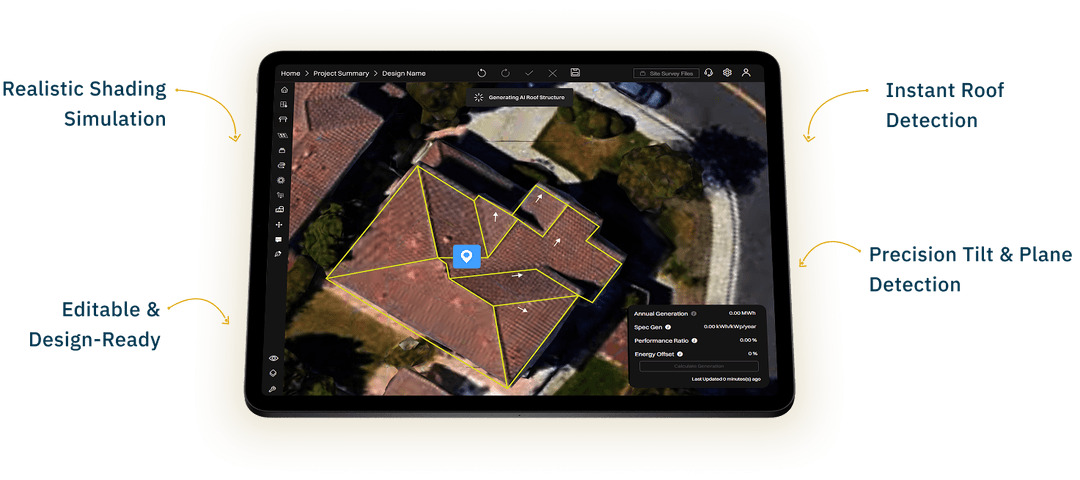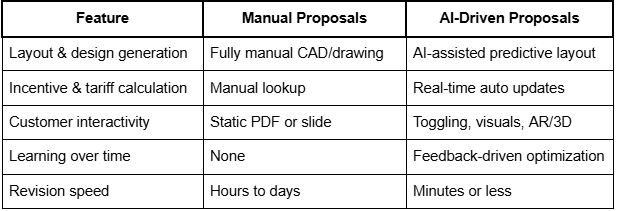
AI in solar proposals uses machine learning and real-time data to auto-generate optimized system layouts, pricing and personalized finance options—delivering professional, interactive proposals in minutes while improving accuracy and customer confidence.
In 2025, AI solar sales proposals are no longer sci-fi. They’re a practical tool in the hands of solar EPCs (engineering, procurement, and construction firms). With AI in solar proposals, teams can speed up design, price dynamically, and deliver a smoother, more trustworthy AI-driven solar proposal software experience to prospects.
In the process, EPCs tighten margins, reduce errors, and improve their closing rates.
When someone asks, “what is AI in solar proposals?” it helps to break it down simply. An AI-driven solar proposal, or solar proposal automation, combines three core ingredients:
In effect, it’s not mere template automation (i.e., “fill in the blanks”)—rather, the AI engine generates the layout, financials, and visuals based on the data and learned logic.
A simplified process flow might look like:
Data inputs → AI engine (ML + rules) → Proposal output + interactive UI
So, “AI proposal software meaning” is this: a system that ingests raw inputs, reasons intelligently, and outputs a polished, personalized proposal instantly. That’s how AI generates solar proposals. This goes beyond simple macros or merge templates; it dynamically reconfigures design, pricing, and visuals based on scenario.
It’s not just hype—2025 really is shaping up to be a pivot year for AI solar proposal trends. Let’s look at why:
Global and U.S. forecasts (via IEA, SEIA) show that solar installations are accelerating, and competition is tighter than ever. EPCs need scale and sales efficiency to survive.
In today’s B2C world, customers expect “instant” responses—from e-commerce to solar quotes. If your competitor sends a polished proposal in minutes, and you take days, you’re already behind.
Incentives, tariffs, and net metering rules change rapidly across states and markets. You need proposals that adapt dynamically. AI proposal automation gives you the agility to recompute costs, incentives, and paybacks on the fly. (Recent analyses of solar policy volatility underscore this need.)
AI and modeling tools are now stable and performant. The risk of early adoption has lowered, making it easier for EPCs to integrate them.
In short, we’ve crossed the threshold: data availability, customer expectations, policy variability, and software readiness have converged to make AI proposals not just desirable, but essential.

Here’s where the rubber meets the road. Below are four pillars of transformation when you bring how AI transforms solar proposals into your workflow.
Also known as AI solar layout design, this is where AI shines. The system proposes optimal panel placement, stringing, spacing, tilt, and trade-offs (efficiency vs. cost). It accounts for shading, structural limits, and electrical constraints.
Dynamic Pricing & Incentive Matching
In real-time solar pricing AI, the proposal engine pulls in up-to-date material costs (modules, inverters, BOS), local incentives (state rebates, tax credits), and tariff rates. It instantly recalculates the pricing, giving you proposals that reflect real market conditions.
One of the most compelling aspects is interactive solar proposals. Customers can toggle options (e.g., include battery, change panel size), view 3D or AR previews, and inspect savings graphs. This level of user experience fast-tracks trust and alignment because customers see “what if” changes in real time.
This is an adaptive AI solar proposal—the system evolves. It tracks which proposals win vs. lose, what discounting was required, and which options were often toggled or rejected. It then learns to bias future proposals to pricing structures or layouts that historically convert better.

This table helps compare traditional vs AI-enabled workflows.
When you front your sales funnel with smart tech, the customer experience improves dramatically. Here’s how:
All this leads to higher close rates, lower drop-off, and more satisfied customers.
You may think, “This sounds great, but how to implement AI proposal software?” Here's an actionable roadmap for how to implement AI proposal software in your solar EPC.
Map out how you collect data, build proposals, handle revisions, and close deals. Note bottlenecks, time delays, and error-prone steps.
Choose a project type or region to pilot AI-powered proposals. Define key success metrics: time per proposal, number of revisions, win rate improvement, and software cost per job.
Shortlist tools that integrate with your CRM, design tools, ERP, or component databases. Ensure APIs or connectors exist
Train the team in the new workflow—how to input data, how to interpret AI suggestions, override options, and respond to feedback loops. Emphasize that AI is an assistant, not a replacement.
Once your pilot shows promise, roll out across territories, refine templates, track feedback, and iterate. Continuously refine your models, update data inputs, and adjust for new incentive policies or market conditions.
One of the most critical questions is: What’s the ROI of AI solar proposals? Let’s break it down simply:
ROI formula (annual):
(Savings per proposal × Proposals/month × 12) – (Software cost + training, integration)
Example scenario:
In reality, you’ll also gain additional closings due to more competitive proposals and an interactive user experience. You could even embed an ROI widget on your site where EPCs input their proposals/month, hours saved, and tool cost to compute their own ROI.
If AI-driven proposals are today’s revolution, the next decade promises an even smarter, more immersive leap forward in the future of AI in solar proposals. The technology is evolving from automation to intuition—anticipating customer needs before they’re even expressed.
The next generation of tools will create fully generative proposals—no templates required. Imagine entering a few client preferences and having the system instantly generate a detailed, visual-rich proposal, complete with an explanatory narrative tailored to the homeowner’s goals. The AI won’t just compile data; it will communicate the value story in a natural, human-like tone.
Future AI proposal systems will act like digital sales assistants. They’ll handle back-and-forth adjustments with customers in real time—automatically recalculating when a buyer requests a change in panel count, financing option, or battery inclusion. This means faster, frictionless interactions and more confident decision-making for both sides.
Visual selling will become the norm. Through augmented or virtual reality previews, customers will be able to “walk” around their virtual roof, view how solar panels will appear, and explore system performance scenarios interactively. This fosters transparency, excitement, and trust from the outset.
We’re moving toward AI agents that generate proposals end-to-end—from lead intake to design and financial modeling—without manual involvement. Human oversight will remain essential, but the repetitive groundwork will be entirely automated, letting teams focus on strategy and relationship building.
In the near future, AI will also handle compliance and permitting tasks. It will auto-attach permit drawings, check for code compliance, and even pre-fill approval documents as part of the proposal process. This will significantly reduce administrative lag and expedite project turnaround times.
The next phase of AI innovation in solar sales is about seamlessness—where proposals, approvals, and contracts merge into one intelligent, adaptive experience. The future of selling solar will be as effortless and interactive as making an online purchase—but far more impactful.
.png)
Q: What does AI actually do in solar proposals?
A: AI ingests site data, energy usage, incentives, and equipment information; runs advanced logic and simulations; and produces optimized layouts, pricing, and visuals. It automates the time-consuming parts of proposal creation, helping teams work smarter and faster.
Q: Are AI-generated proposals accurate and auditable?
A: Yes. AI proposals are backed by transparent data models and traceable inputs. Teams can review every assumption, adjust parameters, and regenerate proposals instantly to maintain full control and accountability.
Q: Can small installers use AI proposals affordably?
A: Absolutely. Many AI-driven solutions are scalable and priced for flexibility. Smaller solar businesses can start with essential features and expand as their project volumes grow—making advanced proposal automation accessible to everyone.
Q: How secure is customer data when using AI proposal tools?
A: Data protection is a top priority. Reputable AI proposal platforms use encryption, secure cloud storage, and compliance with global standards like GDPR. This ensures customer data stays confidential and safeguarded throughout the proposal and project cycle.
.png)
With the help of AI solar proposal software for EPCs are transforming how solar businesses operate—combining speed, precision, and personalization in one intelligent workflow.
That’s where Arka360 stands out. Its AI-powered proposal module brings design, pricing, and customer interaction together, so EPCs can generate accurate, interactive proposals in minutes.
Explore how it works through ARKA360’s solar design software and see how you can take your proposal process to the next level.













